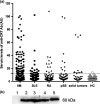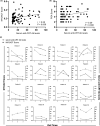A novel autoantibody targeting calreticulin is associated with cancer in patients with idiopathic inflammatory myopathies
- PMID: 33082955
- PMCID: PMC7558046
- DOI: 10.1002/cti2.1195
A novel autoantibody targeting calreticulin is associated with cancer in patients with idiopathic inflammatory myopathies
Abstract
Objectives: To investigate the prevalence and clinical significance of anti-calreticulin autoantibodies (anti-CRT Ab) in a large cohort of idiopathic inflammatory myopathy (IIM) patients.
Methods: Sera from 469 patients with IIM, 196 patients with other connective tissue diseases, 28 patients with solid tumors and 81 healthy controls were screened for anti-CRT Ab by enzyme-linked immunosorbent assay using human recombinant CRT protein. Sera from 35 IIM patients were tested using an immunoprecipitation assay to confirm the presence of anti-CRT Ab. Subsequently, IIM-cancer patients were identified and divided into new-onset, remission and recurrent groups based on their cancer status. The relationships between anti-CRT Ab levels and IIM disease activity were also investigated.
Results: Serum anti-CRT Ab was detected positive in 81 of the 469 (17.3%) IIM patients. Immunoprecipitated bands were observed at a molecular weight of 60 kDa corresponding to the CRT protein. The IIM patients with anti-CRT Ab more frequently had cancers compared to the patients without anti-CRT Ab. Moreover, the prevalence of anti-CRT Ab differed according to the cancer status. The IIM patients with recurrent cancers had a much higher prevalence of anti-CRT Ab than those with cancers in remission. Also, serum anti-CRT Ab levels positively correlated with disease activity at baseline and at follow-up visits.
Conclusion: We report the existence of serum anti-CRT Ab in IIM patients and demonstrate the possible association of anti-CRT Ab with malignancy in IIM patients. Serum anti-CRT Ab could serve as a novel candidate marker of cancer in IIM patients.
Keywords: anti‐calreticulin autoantibodies; biomarkers; idiopathic inflammatory myopathy; malignancy.
© 2020 The Authors. Clinical & Translational Immunology published by John Wiley & Sons Australia, Ltd on behalf of Australian and New Zealand Society for Immunology, Inc.
Conflict of interest statement
The authors declare no conflict of interest.
Figures



Similar articles
-
Anti-calreticulin antibodies and calreticulin in sera of patients diagnosed with dilated or hypertrophic cardiomyopathy.Autoimmunity. 2016 Dec;49(8):554-562. doi: 10.1080/08916934.2016.1214822. Epub 2016 Sep 30. Autoimmunity. 2016. PMID: 27689957
-
Myositis autoantibody profiles and their clinical associations in Greek patients with inflammatory myopathies.Clin Rheumatol. 2019 Jan;38(1):125-132. doi: 10.1007/s10067-018-4267-z. Epub 2018 Aug 25. Clin Rheumatol. 2019. PMID: 30145635
-
Novel classification of idiopathic inflammatory myopathies based on overlap syndrome features and autoantibodies: analysis of 100 French Canadian patients.Medicine (Baltimore). 2005 Jul;84(4):231-249. doi: 10.1097/01.md.0000173991.74008.b0. Medicine (Baltimore). 2005. PMID: 16010208
-
Small intestinal biopsy findings consistent with celiac disease in patients with idiopathic inflammatory myopathy: Review of existing literature.Semin Arthritis Rheum. 2021 Oct;51(5):1033-1044. doi: 10.1016/j.semarthrit.2021.07.012. Epub 2021 Jul 25. Semin Arthritis Rheum. 2021. PMID: 34416625 Review.
-
Detection of multiple myositis-specific autoantibodies in unique patients with idiopathic inflammatory myopathy: A single centre-experience and literature review: Systematic review.Semin Arthritis Rheum. 2021 Apr;51(2):486-494. doi: 10.1016/j.semarthrit.2021.03.012. Epub 2021 Mar 27. Semin Arthritis Rheum. 2021. PMID: 33831755
Cited by
-
Autoantibodies and Cancer Association: the Case of Systemic Sclerosis and Dermatomyositis.Clin Rev Allergy Immunol. 2022 Dec;63(3):330-341. doi: 10.1007/s12016-022-08944-y. Epub 2022 May 20. Clin Rev Allergy Immunol. 2022. PMID: 35593962 Free PMC article. Review.
-
Cystic fibrosis autoantibody signatures associate with Staphylococcus aureus lung infection or cystic fibrosis-related diabetes.Front Immunol. 2023 Sep 11;14:1151422. doi: 10.3389/fimmu.2023.1151422. eCollection 2023. Front Immunol. 2023. PMID: 37767091 Free PMC article.
-
Autoantibodies in the pathogenesis of idiopathic inflammatory myopathies: Does the endoplasmic reticulum stress response have a role?Front Immunol. 2022 Sep 15;13:940122. doi: 10.3389/fimmu.2022.940122. eCollection 2022. Front Immunol. 2022. PMID: 36189221 Free PMC article. Review.
References
-
- Lundberg IE, de Visser M, Werth VP. Classification of myositis. Nat Rev Rheumatol 2018; 14: 269–278. - PubMed
-
- Betteridge Z, McHugh N. Myositis‐specific autoantibodies: an important tool to support diagnosis of myositis. J Intern Med 2016; 280: 8–23. - PubMed
-
- McHugh NJ, Tansley SL. Autoantibodies in myositis. Nat Rev Rheumatol 2018; 14: 290–302. - PubMed
Grants and funding
LinkOut - more resources
Full Text Sources
Research Materials
